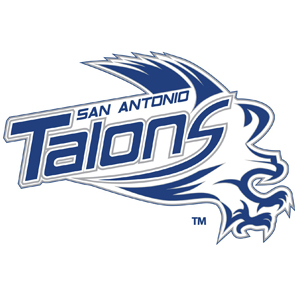 Well, say hello again. It’s been a while. The Arena Football League returns to San Antonio this year after a 20-year absence, and the new team, the Talons, may have an easier time establishing a bright presence than their predecessors. Jason Lohe heads the Talons majority ownership group and acts as CEO and general manager. He is confident the San Antonio Talons will earn a niche in the San Antonio football scene. The Arena Football League, in its various incarnations, has endured a rocky existence, fading in and out of the public eye, with teams coming and going. The league even canceled its 2009 season. Nonetheless, hope springs eternal, even here, despite the dubious showing of the former San Antonio AFL entry, the Force. The Force added a couple of low marks to the record book, suffering a 52-0 devouring by the Orlando Predators and an abysmal season 11.8 field goal percentage — four for 34. The team was sold and it departed. The Force was 2-8 that season, slapping Arizona 43-29 and nipping Dallas 41-40 at the HemisFair Arena, a structure that met its own demise when smacked by a wrecking ball in 1995.
Well, say hello again. It’s been a while. The Arena Football League returns to San Antonio this year after a 20-year absence, and the new team, the Talons, may have an easier time establishing a bright presence than their predecessors. Jason Lohe heads the Talons majority ownership group and acts as CEO and general manager. He is confident the San Antonio Talons will earn a niche in the San Antonio football scene. The Arena Football League, in its various incarnations, has endured a rocky existence, fading in and out of the public eye, with teams coming and going. The league even canceled its 2009 season. Nonetheless, hope springs eternal, even here, despite the dubious showing of the former San Antonio AFL entry, the Force. The Force added a couple of low marks to the record book, suffering a 52-0 devouring by the Orlando Predators and an abysmal season 11.8 field goal percentage — four for 34. The team was sold and it departed. The Force was 2-8 that season, slapping Arizona 43-29 and nipping Dallas 41-40 at the HemisFair Arena, a structure that met its own demise when smacked by a wrecking ball in 1995.
A brighter future
Lohe began negotiations with the Alamodome management team some seven to eight months ago and says “we made a good deal for the dome and for us.”
The team’s inaugural game will be Saturday, March 10, against the Utah Blaze at the dome. It will hold an open-to-the-public mini-camp Feb. 18 at Trinity University.
The current version of the league resulted from a merger of the now defunct af2 (the AFL’s developmental league) and the former AFL in 2010. Simply enough, this AFL is called the new AFL.
The Talons had been members of the developmental league and were included in the merger. They played in Tulsa, Okla., last season and finished with an 8-10 record. The team opted to move to San Antonio because of dwindling attendance and the higher costs of maintenance in the AFL.
Tulsa did well in the af2, winning more games than any other team in af2 history. The Talons were the first af2 franchise to reach 100 overall victories, and they won two af2 championships. The team has been negotiating with local businessmen and is expected to announce a buy-in by a local group in February. Before the move from Tulsa, Lohe looked at the Alamo City market and studied the results of an economic survey taken here. “It showed that there was not enough corporate support for an NFL team (here) but enough for an AFL team,” he says. Despite the Force’s showing, “it still had pretty good crowds,” he adds. The Force averaged 12,015 fans at home.
Lohe intends to put an entertaining and powerful Talons team on the league’s abbreviated 50-yard field.
“That’s why we hired Lee Johnson (as head coach), because he’s the best defensive coordinator in the league,” Lohe says. “We will have a defense to go with our offense. We expect to compete for a title first year in the league, and it would be great if we could set the single game attendance record. It is something that we would set as a goal to show the rest of the league how great San Antonio is.”
The previous record, 28,746, was set in 1993 when Tampa Bay played Orlando in what was then Florida Sun Coast Dome, now Tropicana Field.
Lohe notes that the Talons asked for e-mails from fans interested in coming to the game. “We got back 3,000. You figure you can add friends, wives, children into that number and you’re already up to about 6,000,” he says.
Offensive Power
To direct the Talon offense the team picked up quarterback Aaron Garcia, who won his first Arena Bowl title this past season with the Jacksonville Sharks. He was the Arena Bowl MVP and was named 2011 Offensive Player of the Year. Last season, he closed in on 50,000 passing yards, ending the regular season at 49,996. In Week 8 against the Orlando Predators, Garcia set a professional football record with his 1,000th career touchdown throw in the pass-happy league.
The team will provide a talented receiving corps to support Garcia, including Jomo Wilson, who caught Garcia passes during Jacksonville’s title run; Carl Moore, who played with Tim Tebow at Florida; and San Antonian Robert Quiroga, the Orlando Predators’ top receiver last season. Quiroga attended Holmes High School and Baylor University.
“But it’s important that we bring in not just high-quality players but also high-quality people,” Lohe says. “We want people with high integrity. We expect our players to become involved in the community.”







